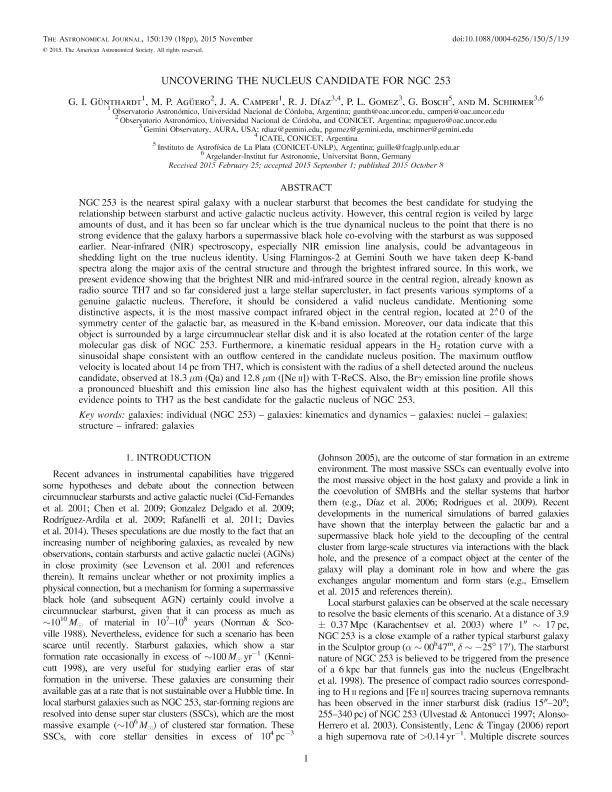Artículo
Uncovering the nucleus candidate for NGC 253
Gunthardt, Guillermo Ivan; Agüero, Maria Paz ; Camperi, Javier Antonio; Diaz, Ruben Joaquin
; Camperi, Javier Antonio; Diaz, Ruben Joaquin ; Gomez, P. L.; Bosch, Guillermo Luis
; Gomez, P. L.; Bosch, Guillermo Luis ; Schirmer, M.
; Schirmer, M.
 ; Camperi, Javier Antonio; Diaz, Ruben Joaquin
; Camperi, Javier Antonio; Diaz, Ruben Joaquin ; Gomez, P. L.; Bosch, Guillermo Luis
; Gomez, P. L.; Bosch, Guillermo Luis ; Schirmer, M.
; Schirmer, M.
Fecha de publicación:
11/2015
Editorial:
IOP Publishing
Revista:
Astronomical Journal
ISSN:
0004-6256
Idioma:
Inglés
Tipo de recurso:
Artículo publicado
Clasificación temática:
Resumen
NGC 253 is the nearest spiral galaxy with a nuclear starburst that becomes the best candidate for studying the relationship between starburst and active galactic nucleus activity. However, this central region is veiled by large amounts of dust, and it has been so far unclear which is the true dynamical nucleus to the point that there is no strong evidence that the galaxy harbors a supermassive black hole co-evolving with the starburst as was supposed earlier. Near-infrared (NIR) spectroscopy, especially NIR emission line analysis, could be advantageous in shedding light on the true nucleus identity. Using Flamingos-2 at Gemini South we have taken deep K-band spectra along the major axis of the central structure and through the brightest infrared source. In this work, we present evidence showing that the brightest NIR and mid-infrared source in the central region, already known as radio source TH7 and so far considered just a large stellar supercluster, in fact presents various symptoms of a genuine galactic nucleus. Therefore, it should be considered a valid nucleus candidate. Mentioning some distinctive aspects, it is the most massive compact infrared object in the central region, located at 2.″0 of the symmetry center of the galactic bar, as measured in the K-band emission. Moreover, our data indicate that this object is surrounded by a large circumnuclear stellar disk and it is also located at the rotation center of the large molecular gas disk of NGC 253. Furthermore, a kinematic residual appears in the H2 rotation curve with a sinusoidal shape consistent with an outflow centered in the candidate nucleus position. The maximum outflow velocity is located about 14 pc from TH7, which is consistent with the radius of a shell detected around the nucleus candidate, observed at 18.3 μm (Qa) and 12.8 μm ([Ne ii]) with T-ReCS. Also, the Brγ emission line profile shows a pronounced blueshift and this emission line also has the highest equivalent width at this position. All this evidence points to TH7 as the best candidate for the galactic nucleus of NGC 253.
Archivos asociados
Licencia
Identificadores
Colecciones
Articulos(CCT - CORDOBA)
Articulos de CTRO.CIENTIFICO TECNOL.CONICET - CORDOBA
Articulos de CTRO.CIENTIFICO TECNOL.CONICET - CORDOBA
Articulos(IALP)
Articulos de INST.DE ASTROFISICA LA PLATA
Articulos de INST.DE ASTROFISICA LA PLATA
Articulos(ICATE)
Articulos de INST.D/CS ASTRONOMICAS D/LA TIERRA Y DEL ESPACIO
Articulos de INST.D/CS ASTRONOMICAS D/LA TIERRA Y DEL ESPACIO
Citación
Gunthardt, Guillermo Ivan; Agüero, Maria Paz; Camperi, Javier Antonio; Diaz, Ruben Joaquin; Gomez, P. L.; et al.; Uncovering the nucleus candidate for NGC 253; IOP Publishing; Astronomical Journal; 150; 5; 11-2015; 1-18; 139
Compartir
Altmétricas
Items relacionados
Mostrando titulos relacionados por título, autor y tema.
-
Artículo New quantitative nitrogen abundance estimations in a sample of Seyfert 2 active galactic nucleiDors Jr., O. L.; Arellano Córdova, K. Z.; Cardaci, Monica Viviana ; Hägele, Guillermo Federico (Wiley Blackwell Publishing, Inc, 2017-06)
-
Dors, Oli L.; Agarwal, B.; Hägele, Guillermo Federico ; Cardaci, Monica Viviana ; Rydberg, Claes Erik; Riffel, R. A.; Oliveira, A. S.; Krabbe, A. C. (Wiley Blackwell Publishing, Inc, 2018-09)
-
Carvalho, S.P.; Dors, O. L.; Cardaci, Monica Viviana ; Hägele, Guillermo Federico ; Krabbe, Nora Cristina; Pérez Montero, E.; Monteiro, A.F.; Armah, M.; Freitas Lemes, P. (Wiley Blackwell Publishing, Inc, 2020-06)



